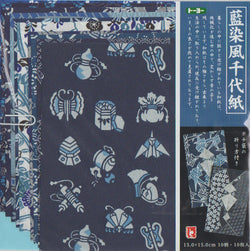Aizome Chiyogami
There exists records of indigo plant cultivation from the 6th century, but aizome (indigo dyeing in Japanese) was originally owned only by aristocrats and samurai. By the 17th century, it had spread to the common people, and various household items were dyed with indigo, including kimonos, hand towels, and bedding. Indigo has antibacterial and insect repellent effects so became quite popular for not just its beauty.
Different methods to extract dye from indigo leaves exist, but a common one handed down to the present day is the method in which leaves are fermented. Indigo leaves are dried and fermented to make sukumo, which contains a concentrated dye component. The sukumo is then mixed with lye or lime and then fermented again. Aizome can create various shades of blue depending on the level of fermentation or the dyeing time. Aizome is currently used to dye many things including table linens, jeans and scarves. Aizome is enjoying a resurgence in popularity. The beauty and luster of the varying shades of indigo never go out of style!
The owner's favorite!
